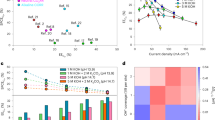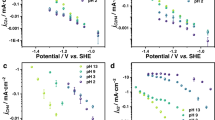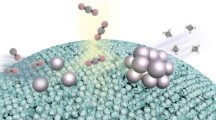Abstract
The electroreduction of CO2 is a promising technology for carbon utilization. Although electrolysis of CO2 or CO2-derived CO can generate important industrial multicarbon feedstocks such as ethylene, ethanol, n-propanol and acetate, most efforts have been devoted to promoting C–C bond formation. Here, we demonstrate that C–N bonds can be formed through co-electrolysis of CO and NH3 with acetamide selectivity of nearly 40% at industrially relevant reaction rates. Full-solvent quantum mechanical calculations show that acetamide forms through nucleophilic addition of NH3 to a surface-bound ketene intermediate, a step that is in competition with OH– addition, which leads to acetate. The C–N formation mechanism was successfully extended to a series of amide products through amine nucleophilic attack on the ketene intermediate. This strategy enables us to form carbon–heteroatom bonds through the electroreduction of CO, expanding the scope of products available from CO2 reduction.
This is a preview of subscription content, access via your institution
Access options
Access Nature and 54 other Nature Portfolio journals
Get Nature+, our best-value online-access subscription
$29.99 / 30 days
cancel any time
Subscribe to this journal
Receive 12 print issues and online access
$259.00 per year
only $21.58 per issue
Buy this article
- Purchase on Springer Link
- Instant access to full article PDF
Prices may be subject to local taxes which are calculated during checkout



Similar content being viewed by others
Data availability
The datasets generated during and/or analysed during the current study are available from the corresponding author on reasonable request.
Code availability
The computational codes used in the current study are available from the corresponding author on reasonable request.
References
Otto, A., Grube, T., Schiebahn, S. & Stolten, D. Closing the loop: captured CO2 as a feedstock in the chemical industry. Energy Environ. Sci. 8, 3283–3297 (2015).
Schiffer, Z. J. & Manthiram, K. Electrification and decarbonization of the chemical industry. Joule 1, 10–14 (2017).
Katelhon, A., Meys, R., Deutz, S., Suh, S. & Bardow A. Climate change mitigation potential of carbon capture and utilization in the chemical industry. Proc. Natl Acad. Sci. USA 116, 11187–11194 (2019).
Montoya, J. H. et al. Materials for solar fuels and chemicals. Nat. Mater. 16, 70–81 (2016).
Haegel, N. M. et al. Terawatt-scale photovoltaics: transform global energy. Science 364, 836–838 (2019).
De Luna, P. et al. What would it take for renewably powered electrosynthesis to displace petrochemical processes? Science 364, eaav3506 (2019).
Verma, S., Lu, S. & Kenis, P. J. A. Co-electrolysis of CO2 and glycerol as a pathway to carbon chemicals with improved technoeconomics due to low electricity consumption. Nature Energy 4, 466–474 (2019).
Nitopi, S. et al. Progress and perspectives of electrochemical CO2 reduction on copper in aqueous electrolyte. Chem. Rev. 119, 7610–7672 (2019).
Jouny, M., Luc, W. & Jiao, F. General techno-economic analysis of CO2 electrolysis systems. Ind. Eng. Chem. Res. 57, 2165–2177 (2018).
Gao, D., Arán-Ais, R. M., Jeon, H. S. & Roldan Cuenya, B. Rational catalyst and electrolyte design for CO2 electroreduction towards multicarbon products. Nat. Catal. 2, 198–210 (2019).
Dinh, C.-T. et al. CO2 electroreduction to ethylene via hydroxide-mediated copper catalysis at an abrupt interface. Science 360, 783 (2018).
Verma, S. et al. Insights into the low overpotential electroreduction of CO2 to CO on a supported gold catalyst in an alkaline flow electrolyzer. ACS Energy Lett. 3, 193–198 (2018).
Li, C. W., Ciston, J. & Kanan, M. W. Electroreduction of carbon monoxide to liquid fuel on oxide-derived nanocrystalline copper. Nature 508, 504–507 (2014).
Verdaguer-Casadevall, A. et al. Probing the active surface sites for CO reduction on oxide-derived copper electrocatalysts. J. Am. Chem. Soc. 137, 9808–9811 (2015).
Bertheussen, E. et al. Acetaldehyde as an intermediate in the electroreduction of carbon monoxide to ethanol on oxide-derived copper. Angew. Chem. Int. Ed. 55, 1450–1454 (2016).
Garza, A. J., Bell, A. T. & Head-Gordon, M. Mechanism of CO2 reduction at copper surfaces: pathways to C2 products. ACS Catal. 8, 1490–1499 (2018).
Pang, Y. et al. Efficient electrocatalytic conversion of carbon monoxide to propanol using fragmented copper. Nat. Catal. 2, 251–258 (2019).
Zhuang, T.-T. et al. Copper nanocavities confine intermediates for efficient electrosynthesis of C3 alcohol fuels from carbon monoxide. Nat. Catal. 1, 946–951 (2018).
Zhang, H., Li, J., Cheng, M.-J. & Lu, Q. CO electroreduction: current development and understanding of Cu-based catalysts. ACS Catal. 9, 49–65 (2018).
Pattabiraman, V. R. & Bode, J. W. Rethinking amide bond synthesis. Nature 480, 471–479 (2011).
Nagib, D. Nitrogen gets radical. Nat. Chem. 11, 396–398 (2019).
Jouny, M., Luc, W. & Jiao, F. High-rate electroreduction of carbon monoxide to multi-carbon products. Nat. Catal. 1, 748–755 (2018).
Cheng, T., Xiao, H. & Goddard, W. A. Reaction mechanisms for the electrochemical reduction of CO2 to CO and formate on the Cu(100) surface at 298 K from quantum mechanics free energy calculations with explicit water. J. Am. Chem. Soc. 138, 13802–13805 (2016).
Cheng, T., Xiao, H. & Goddard, W. A. Full atomistic reaction mechanism with kinetics for CO reduction on Cu(100) from ab initio molecular dynamics free-energy calculations at 298 K. Proc. Natl Acad. Sci. USA 114, 1795–1800 (2017).
Kim, B., Ma, S., Molly Jhong, H.-R. & Kenis, P. J. A. Influence of dilute feed and pH on electrochemical reduction of CO2 to CO on Ag in a continuous flow electrolyzer. Electrochim. Acta 166, 271–276 (2015).
Wang, L. et al. Electrochemical carbon monoxide reduction on polycrystalline copper: effects of potential, pressure, and pH on selectivity toward multicarbon and oxygenated products. ACS Catal. 8, 7445–7454 (2018).
Lum, Y. W. & Ager, J. W. Stability of residual oxides in oxide-derived copper catalysts for electrochemical CO2 reduction investigated with 18O labeling. Angew. Chem. Int. Ed. 57, 551–554 (2018).
Scott, S. B. et al. Absence of oxidized phases in Cu under CO reduction conditions. ACS Energy Lett. 4, 803–804 (2019).
Luc W. et al. Two-dimensional copper nanosheets for electrochemical reduction of carbon monoxide to acetate. Nat Catal. 2, 423–430 (2019).
Lum, Y. W., Cheng, T., Goddard, W. A. & Ager, J. W. Electrochemical CO reduction builds solvent water into oxygenate products. J. Am. Chem. Soc. 140, 9337–9340 (2018).
Cheng, T., Xiao, H. & Goddard, W. A. Free-energy barriers and reaction mechanisms for the electrochemical reduction of CO on the Cu(100) surface, including multiple layers of explicit solvent at pH 0. J. Phys. Chem. Lett. 6, 4767–4773 (2015).
Bagger, A., Arnarson, L., Hansen, M. H., Spohr, E. & Rossmeisl, J. Electrochemical CO reduction: a property of the electrochemical interface. J. Am. Chem. Soc. 141, 1506–1514 (2019).
Calle-Vallejo, F. & Koper, M. T. M. Theoretical considerations on the electroreduction of CO to C2 species on Cu(100) electrodes. Angew. Chem. Int. Ed. 52, 7282–7285 (2013).
Feng, X. F., Jiang, K. L., Fan, S. S. & Kanan, M. W. A direct grain-boundary-activity correlation for CO electroreduction on Cu nanoparticles. ACS Cent. Sci. 2, 169–174 (2016).
Dean J. A., Lange N. A. Lange’s Handbook of Chemistry (McGraw-Hill, 1999).
Lundberg, H., Tinnis, F., Selander, N. & Adolfsson, H. Catalytic amide formation from non-activated carboxylic acids and amines. Chem. Soc. Rev. 43, 2714–2742 (2014).
Watts, J. C. & Larson, P. A. “Dimethylacetamide” in Kirk–Othmer Encyclopedia of Chemical Technology Online (John C. Wiley & Sons, 2002). https://doi.org/10.1002/0471238961.0409130523012020.a01.pub2
McEnaney, J. M. et al. Ammonia synthesis from N2 and H2O using a lithium cycling electrification strategy at atmospheric pressure. Energy Environ. Sci. 10, 1621–1630 (2017).
Jiao, F. & Xu, B. J. Electrochemical ammonia synthesis and ammonia fuel cells. Adv. Mater. 31, 1805173 (2019).
Chen, J. G. et al. Beyond fossil fuel-driven nitrogen transformations. Science 360, eaar6611 (2018).
Liu, K., Smith, W. A. & Burdyny, T. Introductory guide to assembling and operating gas diffusion electrodes for electrochemical CO reduction. ACS Energy Lett. 4, 639–643 (2019).
Lu, X. & Zhao, C. Electrodeposition of hierarchically structured three-dimensional nickel–iron electrodes for efficient oxygen evolution at high current densities. Nat. Commun. 6, 6616 (2015).
Luc, W., Jiang, Z., Chen, J. G. G. & Jiao, F. Role of surface oxophilicity in copper-catalyzed water dissociation. ACS Catal. 8, 9327–9333 (2018).
Acknowledgements
F.J. would like to thank W. Luc for illustration assistance and E. Jeng for help with preparation of the anode. M.J. and J.-J.L. also thank B. Murphy and Z. J. Wang for help with GC–MS. The experimental work was financially supported by the US Department of Energy under award no. DE-FE0029868. F.J. also thanks the National Science Foundation Faculty Early Career Development program (award no. CBET-1350911). J.-J.L. acknowledges financial support from Chinese Scholarship Council. T.C. and W.A.G. were supported by the Joint Center for Artificial Photosynthesis, a DOE Energy Innovation Hub, supported through the Office of Science of the US Department of Energy under award no. DE-SC0004993. This work used the Extreme Science and Engineering Discovery Environment, which is supported by National Science Foundation grant no. ACI-1053575. This research used resources at the 8-ID Beamline of the National Synchrotron Light Source II, a US Department of Energy Office of Science User Facility operated by Brookhaven National Laboratory under contract no. DE-SC0012704. The authors acknowledge E. Stavitski (8-ID Beamline, NSLS-II, Brookhaven National Laboratory) for assistance in X-ray absorption spectroscopy measurements.
Author information
Authors and Affiliations
Contributions
F.J. conceived the idea and supervised the project. M.J. and J.J.-L. performed the electrolysis experiments, analysed the data and wrote the first draft of the manuscript. B.H.K. performed the SEM characterization. T.C. and W.A.G. performed the computational modelling studies. All the authors contributed to the discussion of the results and preparation of the manuscript. M.J., J.J.L. and T.C. have the right to list themselves first in the bibliographic documents.
Corresponding authors
Ethics declarations
Competing interests
M.J., J.-J.L. and F.J. have filed a patent application (international patent application number: PCT/US 19/27012) that is based on the discovery presented in this work.
Additional information
Publisher’s note: Springer Nature remains neutral with regard to jurisdictional claims in published maps and institutional affiliations.
Supplementary information
Supplementary information
Supplementary Figs. 1–15, Tables 1–5 and Methods
Rights and permissions
About this article
Cite this article
Jouny, M., Lv, JJ., Cheng, T. et al. Formation of carbon–nitrogen bonds in carbon monoxide electrolysis. Nat. Chem. 11, 846–851 (2019). https://doi.org/10.1038/s41557-019-0312-z
Received:
Accepted:
Published:
Issue Date:
DOI: https://doi.org/10.1038/s41557-019-0312-z
This article is cited by
-
Sequential co-reduction of nitrate and carbon dioxide enables selective urea electrosynthesis
Nature Communications (2024)
-
Tandem reactors and reactions for CO2 conversion
Nature Chemical Engineering (2024)
-
Electrochemical Carbon Dioxide Reduction in Acidic Media
Electrochemical Energy Reviews (2024)
-
Efficient electrosynthesis of formamide from carbon monoxide and nitrite on a Ru-dispersed Cu nanocluster catalyst
Nature Communications (2023)
-
Selective electrochemical synthesis of urea from nitrate and CO2 via relay catalysis on hybrid catalysts
Nature Catalysis (2023)



